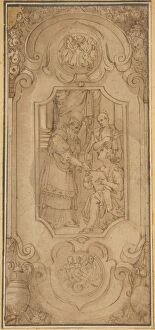1540 42–1609 Collection
"1540-1609: A Time of Plague, Artistry, and Divine Inspiration" During the years 1540 to 1609, a period marked by turmoil and artistic brilliance
All Professionally Made to Order for Quick Shipping
"1540-1609: A Time of Plague, Artistry, and Divine Inspiration" During the years 1540 to 1609, a period marked by turmoil and artistic brilliance, various significant events unfolded. The devastating plague flies in Exodus 8:21 left an indelible mark on society's collective memory during this time. Artists captured the essence of these turbulent times through their drawings and prints. One such artist was known for his bust-length portraits rendered in pen brown ink. Torquato Tasso's former attribution as an artist adds intrigue to his works from this era. His scenes depicting the Last Judgment were meticulously studied for fresco decoration segments. Religious subjects played a central role in art during this period. The coronation of the Virgin, St. Lawrence, Paul, Peter, Sixtus - all found their place within intricate designs featuring cartouches and other decorative elements drawn with pen brown ink on paper. Intriguingly detailed drawings emerged showcasing Christ preaching with fervor during the 16th century. These pieces were created using both pen brown ink and brush techniques that brought life to every stroke. Another captivating study portrayed a half-length man standing frontal view while leaning forward – a testament to the human form's exploration through art at that time. The drawing of a Roman Emperor receiving petition remains undated but serves as evidence of historical documentation prevalent throughout this era. Divine apparitions also inspired artists' pens during these tumultuous years; depictions capturing visions like the Virgin Child appearing before Saint Peter Damasus or Lawrence became popular themes explored by many talented individuals. Amongst all these remarkable creations stands out Paolo Veronese's "Wedding Feast at Cana, " completed between 1540-1609. This masterpiece showcases Veronese's unparalleled skill in capturing grandeur and celebration through his use of color and composition.

















